Algebra | Term 3 Chapter 3 | 7th Maths - Geometrical proof of Identities | 7th Maths : Term 3 Unit 3 : Algebra
Chapter: 7th Maths : Term 3 Unit 3 : Algebra
Geometrical proof of Identities
Geometrical proof of Identities
By using this concept of multiplication
of monomials, let us try to prove the identities geometrically, which are very much
useful in solving algebraic problems.
1. Identity-1: (x + a)(x
+ b) = x2 + x(a + b) + ab
Consider four regions. One region is
square shaped with dimension 3×3 (Grey). Also, the other three regions
are rectangle in shape with dimensions 4×3 (yellow), 3×2
(red) and 4×2 (Blue).
Arrange these four regions to form a
rectangular shape as shown in the Fig. 3.8.
By observing Fig. 3.8, we can
note that,

Area of the bigger rectangle
= Area of a square (Grey ) + Area of Three rectangles
(3 + 4)(3 +2)=(3×3)+(4×3)+(3×2)+(4×2)
(3 + 4)(3 +2)=(3×3)+3×(4 +2)+(4×2) ...(1)
Where, LHS is (3+ 4)(3+2)=7×5=35
RHS is (3 ×3) + 3 ( 4 + 2) + ( 4 ×2) = 9 +(3×6)+8
= 9 +18+8=35
Therefore, LHS = RHS.
In the similar way as explained above,
let us check for another set of four regions as shown in the Fig. 3.9.
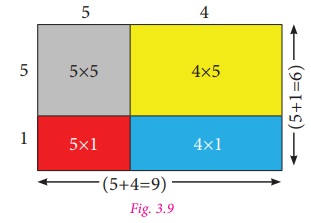
Note
We know that, Area of rectangle
= length × breadth
=l ×b
Also, area of square
=side×side
=a × a =a2
By observing Fig. 3.9, we can
note that,
Area of the bigger rectangle
= Area of a square (Grey ) + Area of Three rectangles
(5+4) (5+1) = (5×5) + (5×1) + (5×4) + (1×4)
(5+4) (5+1) = (5×5) + 5(1+4) + (1×4) ...(2)
Where, LHS is (5 +1)(5 + 4)=6×9 =54
RHS is 52 +5(1+ 4)+(1×4)=25
+(5×5)+ 4
=25+25+4=54
Therefore, LHS = RHS.
Thus, equation (1) and (2) is true for
given set of any three values.
By generalising those three values as
‘x’, ‘a’ and ‘b’
we get, ( x + a)( x +b)= ( x × x) + x (a +b)+ (a ×b)
That is, ( x + a)( x +b)= x2 + x (a +b)+ ab
Hence, (
x + a)( x +b)=
x2 + x (a +b)+ ab is an identity.
Now, let us prove this identity, geometrically.
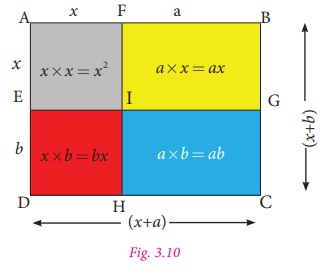
Let one side of a rectangle be (x +a) and
the other
side be (x +
b) units.
Then, the total area of the rectangle
ABCD = length × breadth = (x+a)(x+b) ...(3)
From the Fig. 3.10, we can see that the
Area of the rectangle ABCD
= area of the square AFIE + area of the rectangle FBGI + area of the rectangle EIHD
+ area of the rectangle IGCH
= x 2 + ax +
bx +ab
= x 2 + x(a + b) +ab ...(4)
From (3)
and (4) we get, (x
+
a )(x +b) = x 2 +
x(a + b) +ab
Hence, (
x + a)( x +b) =
x 2 + x (a +b)+ ab is an identity.
Note
(i) In case if b
= −b then the identity is
(x + a )(x +(−b)) = x 2
+ x (a +(−b)) +a(−b)
(x + a )(x −b) = x 2
+ x(a − b) –ab
(ii) If a =−a then the identity is (x
+ (−a))(x + b ) = x 2 + x ((−a ) + b) +(−a )b
(x − a )(x +b) = x 2
+ x(b − a ) –ab
(iii) If a = −a and b = −b then the identity is
(x + (−a ))(x + (−b)) = x2 + x((−a ) +(−b)) +(−a )(−b)
(x − a )(x −b) = x 2
−x(a + b) +ab
Example 3.1
Simplify the following using the identity
(x + a )(x +b) = x2 + x(a
+ b) +ab :
(i) (x + 3) (x + 5) (ii) (y + 8)(y+ 6)
(iii) 43×36
Solution:
(i) (x
+ 3)(x + 5)
Let us represent
the expression geometrically, as shown in the Fig. 3.11.
In the rectangle with length (
x + 5) and breadth (
x + 3), we get,
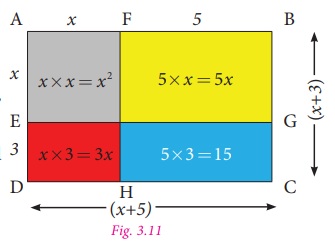
Area of bigger rectangle
= Area of a square + Area of three rectangles
Therefore,
( x + 3)( x + 5)= x2 + 5x + 3x +15
= x2 +(5 +
3)x +15
=x 2 +8x +15
.
(ii) (y + 6)(y + 8)
Let us represent the expression geometrically,
as shown in Fig. 3.12.
In the rectangle with length (
y + 6) and breadth (
y + 8) units,
we get,
Area of bigger rectangle = Area of square + Area of three rectangles
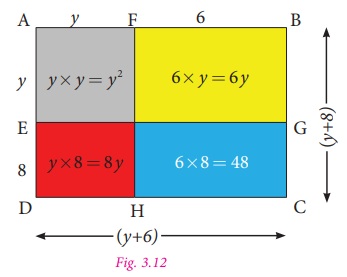
Therefore,
( y + 6)( y + 8)= y 2 + 6 y + 8 y + 48
( y + 6) ( y + 8)= y 2 +(6 + 8)y + 48
= y 2 +14 y + 48
(iii) 43×
36 =(
40 +3)×(
40 −4)
We know the identity
( x + a)( x +b)= x 2 + x (a +b)+ ab
Taking, x = 40, a=3 and
b= –4, we get
(40 +3)(40−4)= 402 + 40(3−4)+3(−4)
=1600 +
40(−1)−12
=1600−40−12
=1600−52
Therefore, 43×
36 =1548
.
2. Identity-2: (a + b) 2 = a2 + 2ab +
b2
Consider four regions. Two square shaped
regions with the dimensions of 3 × 3 (Grey) and 2 × 2 (Blue). Also, there are two
rectangle shaped regions and both are in the dimension of 3 × 2 (yellow).
Arrange them in a square shape as shown
in the Fig. 3.13.
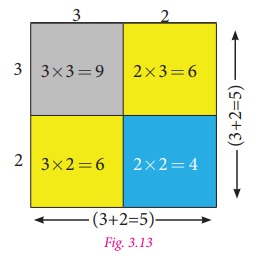
By observing the Fig. 3.13, we
can note that
Area of the bigger square
= Area of two small squares + Area of two rectangles.
(3 + 2)2 = 32
+
(2×3)
+
(3×2)
+
22 = 32 + (3× 2) + (3× 2) + 22 [since, 2×3 = 3×2]
Therefore, (3 +
2)2 = 32 +
2 × (3×
2) +22
where, L.H.S is (3 +
2)2 =52 =25 ……(1)
R.H.S is 32 +
2 ×(3×
2) +22
=
9 +12
+
4 = 25 ……(2)
From (1) and (2), L.H.S = R.H.S.
Now, we can prove this for the variables
a and b.
Let us take a square ABCD of side (a+b),
hence its area is (a +b)(a +b)= (a +b)2
By observing the Fig. 3.14,
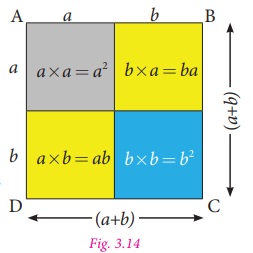
Area of the bigger square
ABCD = Area of two small squares (Grey and blue) + Area of two rectangles (yellow).
So, (a +
b)2 =a 2 + ba +
ab +b2
=a 2 + ab + ab +b2 (since, ba = ab )
(a +b)2 = a 2 + 2ab +b2
Hence proved.
Note
If, we substitute b=
a in the identity (x + a )(x +b) = x 2
+ x(a + b) + ab , we get,
(x + a ) (x + a ) = x2 + x(a + a ) + a × a
(x + a )2 = x 2 + x (2a ) + a2
( x + a )2 = x2 + 2ax +a2 , which is similar to the identity (a +b)2 = a 2 + 2ab +b2 .
Example 3.2
Simplify the following using the identity
(a + b)2 =a 2 + 2ab +b2 .
(i) (2x +5)2
(ii) 212
Solution:
(i) (2
x + 5)2
Let the side of the square be 2x
+5
units.
Then its area is side×side , that is (2
x + 5)2 .
The geometrical representation of the
given expression is as shown in Fig. 3.15.
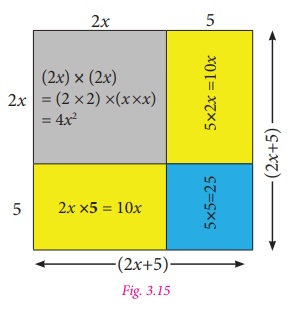
Area of the bigger square
= Area of two squares + Area of two rectangles.
(2 x + 5)2 = 4x2 + 25 + 10x +10x
= 4x2 +(10
+10)x + 25 (Adding
like terms)
= 4 x2 + 20x +25.
(ii) 212
Let the side of the square be 21. Hence,
its area is 212 .
Consider 212 as (20
+1)2 which is one of the way to represent
it geometrically as shown in Fig. 3.16.
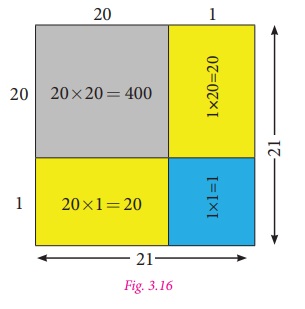
Now,
Area of the bigger square
= Area of two squares + Area of two rectangles.
212 = 400+1+20+20=441.
Aliter method:
We know the identity, (a +b )2 = (a +b)(a +b)
= a 2 + 2ab +b2
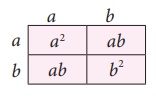
To find the value of 212,
We take, 212 = (20
+1)2
= (20
+1)(20
+1)
Here, a = 20 and b = 1.
Therefore,
a2 + 2ab + b2 =
202 +2×
20×1+12
=400+40+1 =441.
3. Identity-3: (a − b)2
= a2 −2ab +b2
When we replace ‘b’ by ‘–b’
in ‘identity-2’, we get a new identity.

We know that, (a +b)2 = a2 +
2ab +b2
Taking ‘b’ as ‘–b’ in ‘identity-2’,
we get, [a + (−b)]2 = a2 +
2a(−b)+ (−b)2
(a −b)2 = a2 −2ab + (−b)(−b)
Therefore, (a −b)2 = a2 −2ab
+b2
Note that, when we change the sign of
b, the sign of 2ab (second term) alone is changed.
Example 3.3
Using the identity (a −
b)2 = a2 − 2ab +b2 , simplify the following:
(i) (3x -5y)2
(ii) 472
Solution:
(i) (3x -5y)2
Put a = 3x and b = 5y in the identity (a
−
b)2 =a2 − 2ab +b2 , we get,
(3x -5y)2 =(3x)2
−
2 ×(3x)×
(5y) +(5y)2
=32 ×x2 − (2×3× 5)xy +(52
×y2 )
= 9 x2 −30xy +25y2.
(ii) 472 =
(50 −3)2
, substituting a =50 and b = 3 in the identity (a
−
b)2 =a2 − 2ab +b2, we get,
(50-3)2=502−2×50×3+32
= 2500 − 300 + 9
=2509 − 300 = 2209.
4. Identity-4: (a + b)(a − b)= a2–b2
In the given figure, AB = AD = a.
So, area of square ABCD = a2 .
Also, SB= DP= b
Area of the rectangle SBCT = ab.
Similarly, area of the rectangle DPRC=
ab.
Also, area of the square TQRC= b2 .
Area of the rectangle DPQT ab − b2 .
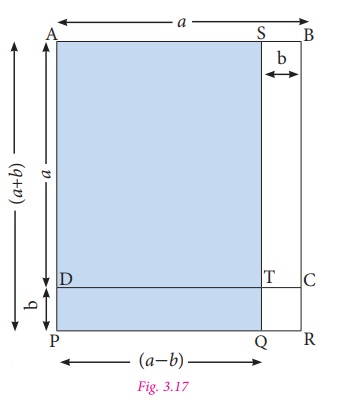
Now, AS = PQ = (a − b) and AP = SQ = (a + b).
Hence, area of the rectangle APQS (the
shaded rectangle) = area of square ABCD –
area of rectangle STCB + area of rectangle DPQT
= a2–ab + (ab–b2)
= a2–ab + ab – b2
= a2 – b2
Hence, (a + b) (a – b) = a2 – b2
Example 3.4
Simplify by using the identity (a + b)(a − b) = a2 – b2
(i) (3x + 4)(3x − 4)
(ii) 53 × 47.
Solution:
(i) (3x + 4)(3x − 4)
Substitute, a=3x and b=4
in the identity (a +b)×(a −b)= a 2
−b2, we get,
(3x + 4)(3x − 4) =
(3x)2 −42
(33 ×
x3) −16 = 9 x2 −16
.
(ii) 53×47 = (50+3)×(50−3).
Take, a =50 and b = 3,
Substituting the values of ‘a’ and ‘b’
in the identity (a + b)(a – b) = (a2
– b2), we get,
= 502 −32
= 2500 − 9
=2491.
Try this
Consider a square shaped paddy field with side of 48 m. A
pathway with uniform breadth is surrounded the square field and the length of the
outer side is 52 m. Can you find the area of the pathway by using identities?
Solution:
Let a = 52
b = 4
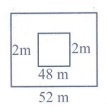
(a–b)2 = a2 – 2ab + b2
= 522 –
2 (52) (4) + 42
= 2704 – 416 + 16
= 2304
Related Topics